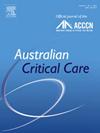Deciding who decides: An interview study exploring the factors affecting emergency department and intensive care unit health professionals’ understanding and application of the law on end-of-life decision-making
IF 2.7
3区 医学
Q2 CRITICAL CARE MEDICINE
引用次数: 0
Abstract
Background
All health care is underpinned by legal frameworks, including those that regulate who is responsible for healthcare decisions at the end of life. How these frameworks support decision-making in emergency departments (EDs) and intensive care units (ICUs) is underexplored.
Objective
The objective of this study was to identify factors that help or hinder healthcare professionals' understanding and application of the law that applies to end-of-life decision-making in the EDs and ICUs in Queensland, Australia.
Methods
A descriptive qualitative study based on naturalistic inquiry was undertaken. Participants were healthcare professionals working in the ICUs or EDs of one South East Queensland Hospital and Health Service, responsible for the care of adult patients who had died.
Results
Thirteen medical practitioners, 19 registered nurses, and three social workers participated in semistructured interviews. Three themes and eight subthemes were identified in the data. First, the theme the complexity of communication is laid bare at the end of life described the challenges associated with talking about death and dying and the need to reframe conversations where death is inevitable. Next, the theme decision-making has layers highlighted family inclusion in decisions, navigating different perspectives to share decision-making and acknowledging that decision-making is emotionally burdensome. Finally, the theme how the law should apply is uncertain described the difficulties in deciding who should decide, knowing when Advance Health Directives can be relied on, and the need to reduce legal risk.
Conclusion
Decision-making at the end of life is complex and challenging. Healthcare professionals charged with leading conversations find them challenging and are mindful of the burdens associated with such decisions. The need to work within the legal framework is acknowledged, but applying the law can be difficult.
决定谁决定:一项访谈研究,探讨影响急诊科和重症监护病房卫生专业人员对临终决策法律的理解和应用的因素
所有卫生保健都以法律框架为基础,包括规定谁对生命终结时的卫生保健决定负责的法律框架。这些框架如何支持急诊科(ed)和重症监护病房(icu)的决策尚未得到充分探讨。本研究的目的是确定有助于或阻碍医疗保健专业人员理解和应用适用于澳大利亚昆士兰州急诊科和icu临终决策的法律的因素。方法采用基于自然主义调查的描述性定性研究方法。参与者是在一家东南昆士兰医院和卫生服务部门的icu或急诊科工作的医疗保健专业人员,负责照顾已经死亡的成年患者。结果13名执业医师、19名注册护士和3名社工参与了半结构式访谈。数据中确定了三个主题和八个副主题。首先,“生命终结时沟通的复杂性暴露无遗”这一主题描述了与谈论死亡和临终相关的挑战,以及在死亡不可避免的情况下重新构建对话的必要性。其次,主题决策有层次,强调家庭参与决策,引导不同的观点来分享决策,并承认决策是情感上的负担。最后,“法律应如何适用是不确定的”这一主题描述了在决定由谁来决定、知道何时可依赖预先健康指示以及减少法律风险的必要性方面的困难。结论生命末期的决策是复杂且具有挑战性的。负责引导对话的医疗保健专业人员发现这些对话具有挑战性,并注意到与此类决定相关的负担。在法律框架内开展工作的必要性得到承认,但实施法律可能很困难。
本文章由计算机程序翻译,如有差异,请以英文原文为准。
求助全文
约1分钟内获得全文
求助全文
来源期刊

Australian Critical Care
NURSING-NURSING
CiteScore
4.90
自引率
9.10%
发文量
148
审稿时长
>12 weeks
期刊介绍:
Australian Critical Care is the official journal of the Australian College of Critical Care Nurses (ACCCN). It is a bi-monthly peer-reviewed journal, providing clinically relevant research, reviews and articles of interest to the critical care community. Australian Critical Care publishes peer-reviewed scholarly papers that report research findings, research-based reviews, discussion papers and commentaries which are of interest to an international readership of critical care practitioners, educators, administrators and researchers. Interprofessional articles are welcomed.
 求助内容:
求助内容: 应助结果提醒方式:
应助结果提醒方式:


